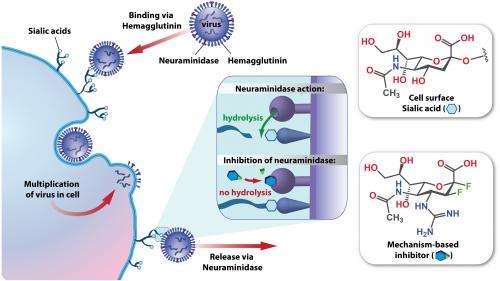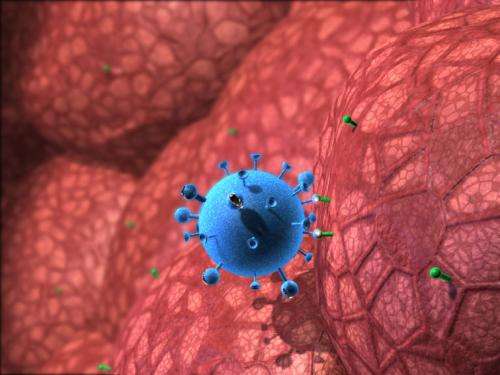This figure shows the life cycle of the flu virus and how the new flu drug agent prevents the virus from spreading from cell to cell by irreversibly inhibiting the action of the neuraminidase like a broken key left in a lock. Credit: Tom Wennekes, UBC
A new class of influenza drug has been shown effective against drug-resistant strains of the flu virus, according to a study led by University of British Columbia researchers.
Published online today in the journal Science Express, the study details the development of a new drug candidate that prevents the flu virus from spreading from one cell to the next. The drug is shown to successfully treat mice with lethal strains of the flu virus.
In order to spread in the body, the flu virus (blue) first uses a protein, called hemagglutinin, to bind to the receptors (green) on a healthy cell (red).
In order to spread in the body, the flu virus first uses a protein, called hemagglutinin, to bind to the healthy cell's receptors. Once it has inserted its RNA and replicated, the virus uses an enzyme, called neuraminidase, to sever the connection and move on to the next healthy cell.
"Our drug agent uses the same approach as current flu treatments – by preventing neuraminidase from cutting its ties with the infected cell," says UBC Chemistry Prof. Steve Withers, the study's senior author. "But our agent latches onto this enzyme like a broken key, stuck in a lock, rendering it useless."
The World Health Organization estimates that influenza affects three to five million people globally each year, causing 250,000 to 500,000 deaths. In some pandemic years, the figure rose to millions.
"One of the major challenges of the current flu treatments is that new strains of the flu virus are becoming resistant, leaving us vulnerable to the next pandemic," says Withers, whose team includes researchers from Canada, the UK, and Australia.
"By taking advantage of the virus's own 'molecular machinery' to attach itself," Withers adds. "The new drug could remain effective longer, since resistant virus strains cannot arise without destroying their own mechanism for infection."
More information: "Mechanism-Based Covalent Neuraminidase Inhibitors with Broad Spectrum Influenza Antiviral Activity," by J.-H; Kim et al, Science, 2013.
Journal information: Science Express
Provided by University of British Columbia




















